I’ve been a Maurice Sendak fan ever since the book Where the Wild Things Are was read to us in grade school, and for years now, I’ve been trying to complete my Maurice Sendak collection.
I’m a little bit closer to that goal this year, as I’ve lucked out on a bunch of Maurice Sendak books in the past months: Alligators All Around: An Alphabet; The Moon Jumpers; The Miami Giant; I Saw Esau: A Schoolchild’s Pocket Book; and finally, Making Mischief: A Maurice Sendak Appreciation, books #56-61 for 2011.
 Alligators All Around: An Alphabet, written and illustrated by Maurice Sendak, paperback
Alligators All Around: An Alphabet, written and illustrated by Maurice Sendak, paperback
This 1962 pocket-sized ABC book showcases each letter represented by an alliterated phrase. It starts off with “Alligators all around…” and continues to tell us what the other alligators are doing — bursting balloons, catching colds, doing dishes… and so on. Each letter is accompanied by a funny illustration that captures the equally funny featured phrase.
I love alphabet books, and this one’s a delight, both for its humor and its uniqueness. Despite the printing that gives the book flat, minimal color, these anthropomorphic alligators are anything but boring, because they DO get around, doing the strangest things!
This book is from Sendak’s Nutshell library collection, one of his solo works that came out a year before Where the Wild Things Are, and the illustrations are done with thick ink outlines, and flat, 60s technicolor. Nevertheless, the alligators are drawn with such personalities — snooty turned-up noses (snouts?), cheeky grins, sour grimaces, and more!
Here are a few snapshots:
It’s a great book for kids and adults alike, both human and alligator :)
4/5 stars
***
 The Moon Jumpers by Janice May Udry, illustrated by Maurice Sendak, hardcover
The Moon Jumpers by Janice May Udry, illustrated by Maurice Sendak, hardcover
I wasn’t familiar with this 1959 book, but the Caldecott Honor sticker glinting on the cover caught my eye, and my amazement grew when I found out the pictures were by Sendak.
The story is old-fashioned and charming, about what kids did when the moon came out (in the days before gaming consoles and computers): they danced in the grass, made up songs and poems, told ghost stories, jumped in an attempt to touch the moon — all until it was time for bed.
The story stirred childhood memories because that’s exactly how we spent nights when I was a kid. Especially during the year the whole country was experiencing power outages! We would play shadow tag in the streets under the moonlight, huddle up on woven mats and tell ghost stories, or sing at the top of our voices from the terrace, dangling our feet from the gaps in the railing.
Sendak’s illustration style for this book is also quite different from his other works — I think this is one of his few published works without visible outlines, which is why I didn’t recognize it as Sendak off the bat. The pictures are soft and highly textured, and his light and shadows, along with the color palette, make the pictures look as if they were shot through with moonlight!
Look:
I wish kids today (and tomorrow) still get to experience such simple pleasures.
5/5 stars
***
 The Miami Giant by Arthur Yorinks, illustrated by Maurice Sendak, hardcover
The Miami Giant by Arthur Yorinks, illustrated by Maurice Sendak, hardcover
This book is story about Italian explorer Giovanni Gaweeni, who sets off on the seven seas to look for China, but instead, the ship arrives in Miami. Giaweeni discovers a lost tribe of dancing giants, and chaos occurs when he decides to bring one of the giants on his return voyage.
Sendak’s exhuberant illustrations match the story perfectly, and I love how the illustrations bleed right out of the pages, emphasizing the gigantism of the Mishbookers. The proportions also make the drawings nice and big for storytelling.
It’s silly and outlandish, and the various jokes hidden both in the story and the illustrations are guaranteed to draw laughs from readers of all ages.
Check it out:
4/5 stars
***
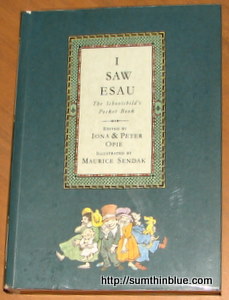 I Saw Esau: The Schoolchild’s Pocket Book edited by Iona and Peter Opie, paperback
I Saw Esau: The Schoolchild’s Pocket Book edited by Iona and Peter Opie, paperback
This book is actually a 2000 updated release of the 1947 book I Saw Esau: traditional rhymes of youth, which was a compilation of rhymes uniquely belonging to schoolchildren, starting with the popular “I Saw Esau.” Iona and Peter Opie are recognized as British folklorists specializing in anthologies of children’s literature and games from the 16th to 20th century, said to be the greatest collection of children’s lit with over 20,000 pieces. The collection is now with the Bodleian Library in Oxford, which had raised funds to acquire the collection in the 80s.
A British children’s publisher, Walker Books, particularly its founder Sebastian Walker, got the Opie’s last remaining copy of the 1947 edition, brought it to America and showed it to Maurice Sendak, who liked it and immediately got to work on the book.
I like the philosophy of this book, which is a feast of laughter. Iona Opie says in her introduction, “The best antidote to the anxieties and disasters of life is laughter; and this children seem to understand almost as soon as they are born. If laughter is lacking, they create it; if it is offered to them, they relish it…. it is a help, this book, to our universal predicament. We find we are born, so we might as well stay and do as well we can, and while we are here we can at least enjoy the endearing absurdities of humankind.
Sendak’s illustrations in this book are absolutely lovely, and the thick paper and high quality printing of this book only enhance it.
Here are some pages from the book:
 the frontispiece: an illustration of the Publisher, the Artist, and the Editors
the frontispiece: an illustration of the Publisher, the Artist, and the Editors
and my absolute favorite:
5/5 stars
***
 Making Mischief: A Maurice Sendak Appreciation by Gregory Maguire, hardcover
Making Mischief: A Maurice Sendak Appreciation by Gregory Maguire, hardcover
This chance find this Maurice Sendak tribute at the bargain bookstore was a lovely surprise.
Maguire talks about meeting Sendak in 1977 and his continuing admiration for Sendak’s work. He starts off by examining Sendak’s artistic influences — from paintings of the masters to Walt Disney, Ralph Caldecott, Herman Melville, William Blake, and many more.
He also tackles the recurring motifs in Sendak’s body of work, such as flying. books, creatures big and small, and the range of emotions experienced by children. He proceeds to discuss Sendak’s illustration style, with its cubic architecture and skewed perspective, supporting characters that look uncannily alike, the translucency of his washes and use of cross hatching, and his composition’s shallow depth of field, as if watching a play unfold on a stage.
Maguire posits a horrific situation: if all of Sendak’s artwork were in a burning building, which ten would you save? And he proceeds to rattle off his choices — very very interesting.
And finally, he proposes that nearly all of Sendak’s work is an echo of Where the Wild Things Are, and presents as proof, a retelling of WTWTA using different pages from Sendak’s works! “The master thief has stolen most often from himself,” Maguire suggests, and I think he’s got something there!
Chock-full of Maurice Sendak’s illustrations, this book is absolutely essential for all Sendak fans.
5/5 stars
***
At 10 books, I’m still a long way away from completing my Maurice Sendak collection, but I sure won’t stop until I have all his books!





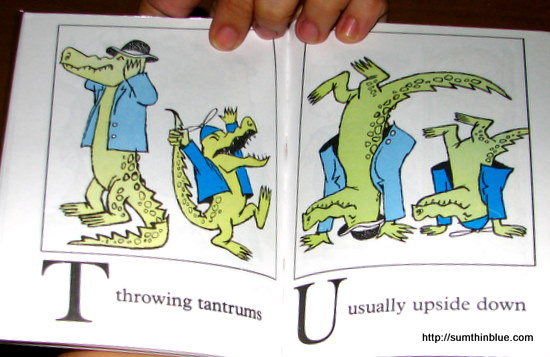





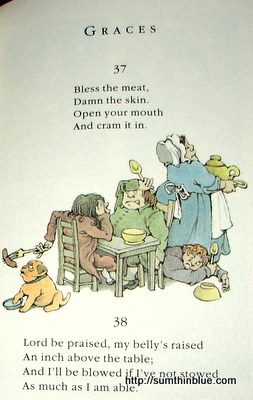

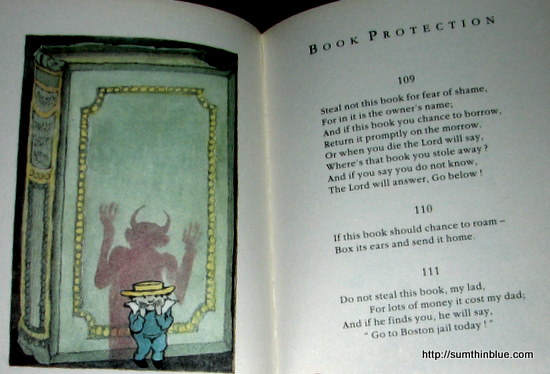


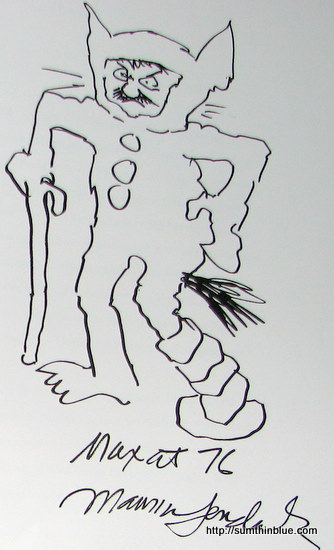

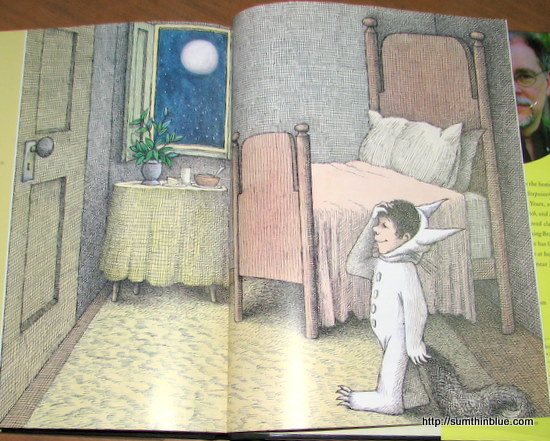
I watched the movie Where The Wild things are- but i guess I don’t really like it.
I didn’t like the movie either :(
the movie was horrible. but i’ve always loved maurice sendak :) thanks for the peek into more of his books!
it was, wasn’t it? I had waited for it for so many months and I felt utterly wretched after watching it.
Hullo Blooey!
This is a very coincidental post as I chanced upon a 1963 edition of “Where the Wild Things Are” at Booksale just yesterday. Undoubtedly, it was my first Sendak.
Thanks for a peek at some of his books and I’m got too to collect some of his works. I really like his illustrations and his run-on sentences.
My warm regards and happy reading! ^_^
Oh, that’s great, I have one too :) The 1963 is a first edition.
WTWTA is actually the first in Sendak’s masterpiece trilogy — the next books are In the Night Kitchen and Outside Over There.
My kids and I love Maurice Sendak too.
Where the Wild Things are was first read to me in school when I was a kid — and I’ve never outgrown it!